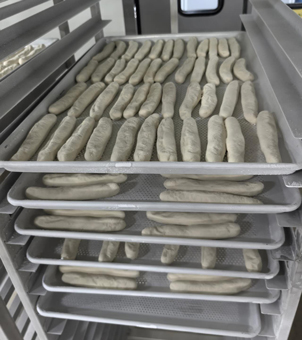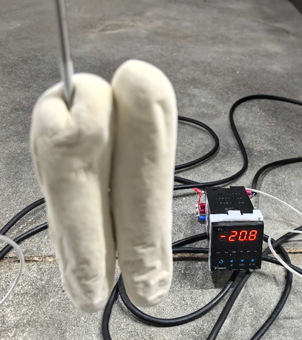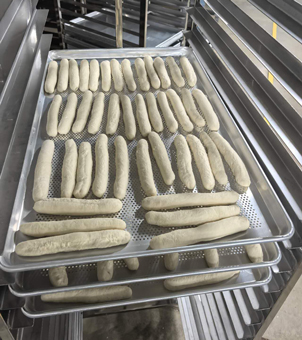In the cold chain and quick freezing industry, the term initial cooling time describes the gap between when food leaves processing (such as an oven, fryer, or slicer) and when it enters the freezing zone where its temperature begins to drop rapidly. Though this stage is often overlooked, it is the first quality control step in freezing. It affects ice-crystal size, cell structure, nutrient retention, and microbial activity, all of which determine frozen food quality—including texture, appearance, safety, and shelf stability. For producers, optimizing this period reduces waste, improves consistency, and adds value to every batch.
1. What Is Initial Cooling Time in Quick Freezing?
This phase includes two key parts:
Pre-cooling or transfer time: the waiting period between cooking and when food is placed into the freezer.
Critical freezing zone crossing: the time it takes for the core temperature to pass through −1°C to −5°C, where most ice-crystal damage occurs.
Using temperature probes and monitoring tools, manufacturers can measure these times and set control points. The shorter these windows, the higher the likelihood of achieving premium frozen product texture and minimal drip loss.
2. Why Ice Formation Depends on Initial Cooling Time
The science is simple: slow cooling produces large, uneven ice crystals that break cell walls, leading to fluid loss and poor thawing results. Fast cooling, on the other hand, forms micro-crystals that protect tissue integrity. This is why liquid nitrogen freezers (LN₂ freezers) are widely used in high-value applications—they enable food to pass through the critical ice-crystal range in seconds, preserving nutrient retention in frozen food and natural taste.
3. How Product Quality Is Affected
Texture and mouthfeel: Fast initial cooling creates fine ice crystals, keeping bite and chewiness close to fresh.
Appearance and drip loss: Reduced cell rupture means better elasticity, brighter color, and less liquid loss after thawing.
Nutritional value: Vitamins like C and B-complex remain higher when cell fluids don’t leak.
Flavor protection: Rapid freezing locks in volatile aromas and reduces fat oxidation.
Food safety: Less time in the danger zone slows microbial growth and keeps food safer.



4. Factors That Influence Initial Cooling Time
Product-related
Thickness and shape: thicker cuts take longer to freeze.
Water, sugar, or fat content: high water speeds cooling; sugar or fat slows it down.
Entry temperature: pre-chilled food (0–4°C) freezes faster than hot products.
Process and equipment
Cooling method: liquid nitrogen freezers deliver much faster results than air blast or mechanical freezers.
Heat transfer: immersion or spray freezing outperforms still-air methods.
Loading style: single-layer spreading is always faster than stacking.
Operational management
Production rhythm: delays between processing and freezing extend initial cooling.
Monitoring tools: without sensors and data logging, variation is hard to control.
5. Measuring and Controlling Cooling Time
To manage this step, manufacturers rely on:
Core and surface probes for temperature curves.
IR sensors to evaluate freezer performance.
Data logging for LN₂ flow, conveyor speed, and dwell time.
Control points include:
Maximum pre-cool waiting time.
Speed of crossing the ice-crystal range.
Final core temperature at freezer exit.
By setting these benchmarks, companies can standardize quick freezing performance.
6. Practical Strategies for Optimization
Pre-chill hot food to 0–4°C before freezing.
Two-stage freezing: a short hardening phase followed by deeper core cooling.
Single-layer spacing: avoid stacking to allow full air or LN₂ contact.
Streamline logistics: shorten distance from processing to freezer entry.
Use LN₂ freezing equipment: best for premium, small-batch, or sensitive products.
7. Validation Through Testing
Pilot tests help confirm benefits:
Record different waiting times and cooling curves.
Compare thawed product drip loss, texture, and flavor stability.
Measure nutrient retention and lipid oxidation.
Set acceptance standards to lock in consistent frozen food quality.
8. Misconceptions to Avoid
“Faster is always better”: overly hard freezing may damage coatings.
“Only exit temperature matters”: the rate of cooling is just as important.
“Freezing alone guarantees quality”: packaging and thawing also affect results.
9. Cost and Benefits of Shorter Initial Cooling Time
While stronger cold sources like LN₂ may increase peak energy use, the payback comes in reduced product loss, longer shelf life, and better sales value. Many processors find that upgrading to a liquid nitrogen freezer improves both quality and profit margins.
10. Implementation Checklist
Define targets for waiting time and freezing curves.
Choose the right freezer technology for your line.
Build a database of product temperature profiles.
Train operators on handling and loading.
Install probes, sensors, and alarms for real-time monitoring.
Run pilot trials and refine SOPs.
11. Initial Cooling as the First Gate of Frozen Food Quality
Managing initial cooling time is not just a technical detail—it is the first gate of frozen food quality control. Proper control improves texture, flavor, nutrient retention, and safety, while reducing waste and boosting ROI.
At SPEEDCRYO, I help companies integrate liquid nitrogen freezing solutions into their production lines, from layout design to pilot testing. By controlling this critical time window, manufacturers can turn theory into reliable results and stay competitive in today’s cold chain market.
